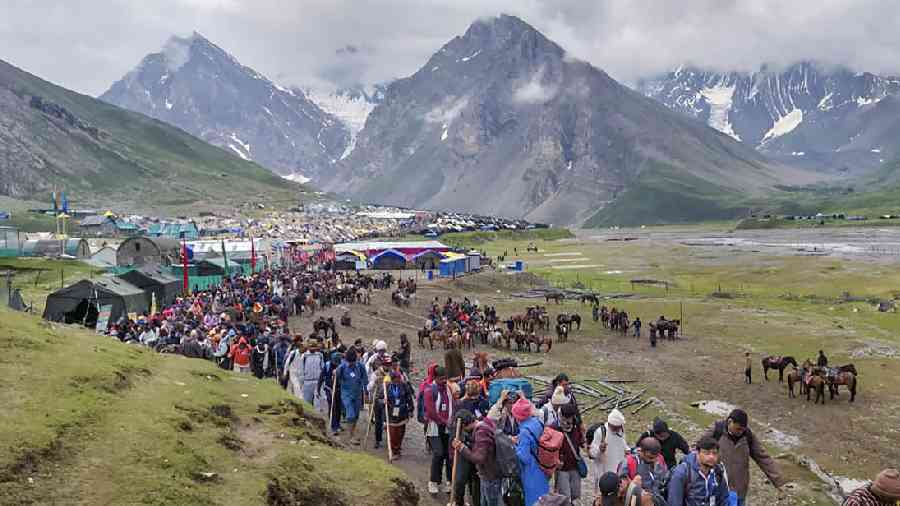The Centre has announced a Rs 5,300-crore Amarnath Marg — a 110km motorable road and a 5km concrete pedestrian track — to the Amarnath Cave in the higher reaches of the Himalaya, raising the spectre of an “environmental disaster” in the picturesque Lidder and Sindh valleys.
Pahalgam and Sonamarg, the two most famous tourist destinations in Kashmir, are located in the Lidder and Sindh valleys, respectively.
The 110km road will connect the twin base camps for the Amarnath Yatra — Chandanwari in south Kashmir and Baltal in central Kashmir — but will pass through a fragile mountainous landscape. A longer, 200km motorable road exists between Chandawari and Baltal and passes through Srinagar.
On Tuesday, Union road transport minister Nitin Gadkari “happily” announced that the government had given its consent for the first leg of the project — a 73km, four-lane road from Khannabal to Chandanwari in south Kashmir’s Anantnag district — to be laid at a cost of Rs 1,800 crore.
The second phase entails a 37km, two-lane road from Chandanwari to Panchtarni, the last important milestone ahead of the cave, and then to Baltal, the base camp in Sonamarg. This part of the project will cost Rs 3,500 crore.
The project also envisions a 10.8km-long tunnel from Sheshnag to Panchtarni.
“For the 5km distance from Panchtarni to the holy cave shrine, a 5.5m broad concrete pedestrian track with barricades on either side will also be constructed,” Gadkari said.
A much smaller proposal in 2008 to transfer 100 acres of forest land to the Shri Amarnath Shrine Board for building temporary shelters for pilgrims had triggered an unprecedented months-long agitation, forcing the government to abandon the plan.
The project was opposed for both environmental and religious reasons as many feared it was a ploy to change the demography of Kashmir by settling non-locals in the Valley.
Kashmir has this time only reacted in hushed tones to the announcement of the massive project on Tuesday, apparently over fears of retribution or perhaps because such announcements have become the new normal in the Valley.
“Nitin Gadkari in Kashmir. Government of India to build 110km Amarnath Marg in Kashmir, connecting the holy cave shrine in the Himalaya with the mainland. An ecological disaster in the making?” tweeted Jehangir Ali, a journalist, voicing fear that the brittle mountains might not be able to take the burden of the constructions for the project. He is one of the few local voices to comment on the project.
Environmentalist Dr Raja Muzaffar Bhat said a road would trigger an environmental and ecological disaster.
“You will have to cut raw fragile mountains. You have seen what happened in places like Joshimath or Kedarnath. The place is home to the Kolahoi glacier, which is already melting, and an abnormal increase in footprints will make it more vulnerable,” Bhat told The Telegraph.
“It is a forest area and you have wildlife reserves in the vicinity. Carbon emissions will increase. It will be better if some credible institute carries out an environmental assessment before the project gets the nod,” he added.
Kolahoi is the main source of the Lidder stream, whose water is used for drinking and agricultural purposes in south Kashmir. It is the main tributary of the Jehlum. The Sindh stream in central Kashmir also flows into the Jehlum.
Gadkari said the road to Amarnath would drastically reduce the travel time of pilgrims from three days to 8-9 hours through the Pahalgam route.
The minister said attempts were underway to complete the 670km-long Delhi-Amritsar-Katra Green Expressway to the Mata Vaishno Devi shrine in Jammu before the imposition of the model code of conduct for the Lok Sabha elections next year. It is being constructed at a cost of Rs 40,000 crore.
Kashmiri politicians have routinely accused the Centre of turning the weeks-long annual Amarnath Yatra into a political event.
The government has over the years rebuffed environmental concerns by increasing the number of pilgrims and the duration of the Yatra.
Large parts of the Valley were literally converted into a fortress last year to prevent militant attacks in the wake of increased targeted killings.
While the Yatra passed off peacefully, weather played spoilsport with 15 pilgrims losing their lives and dozens suffering injuries in flashfloods triggered by a landslide.











